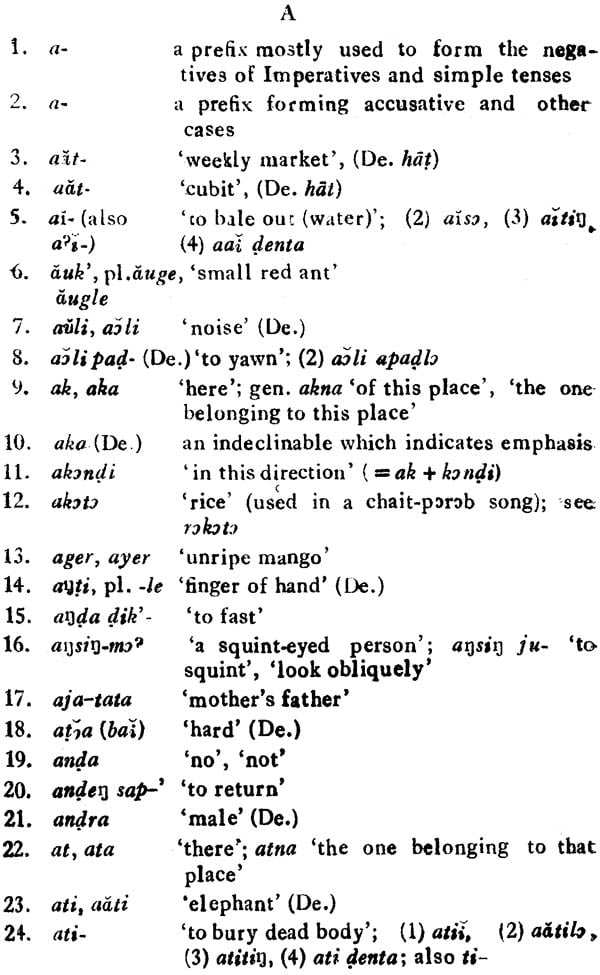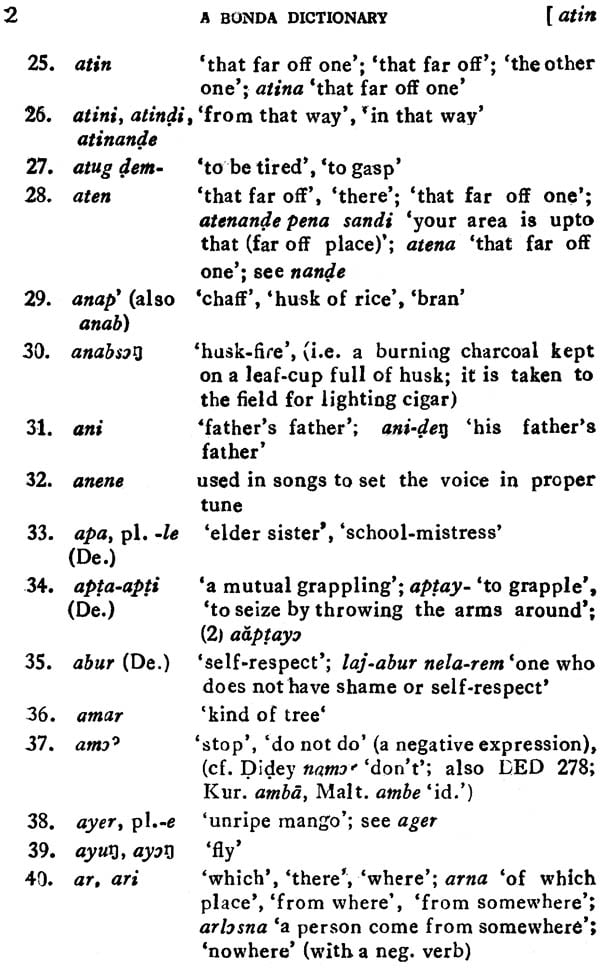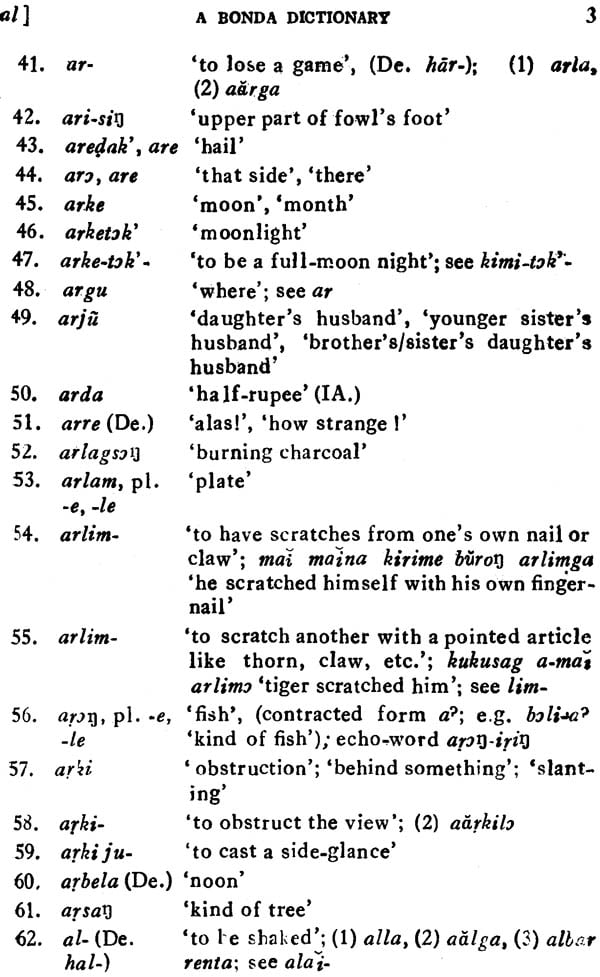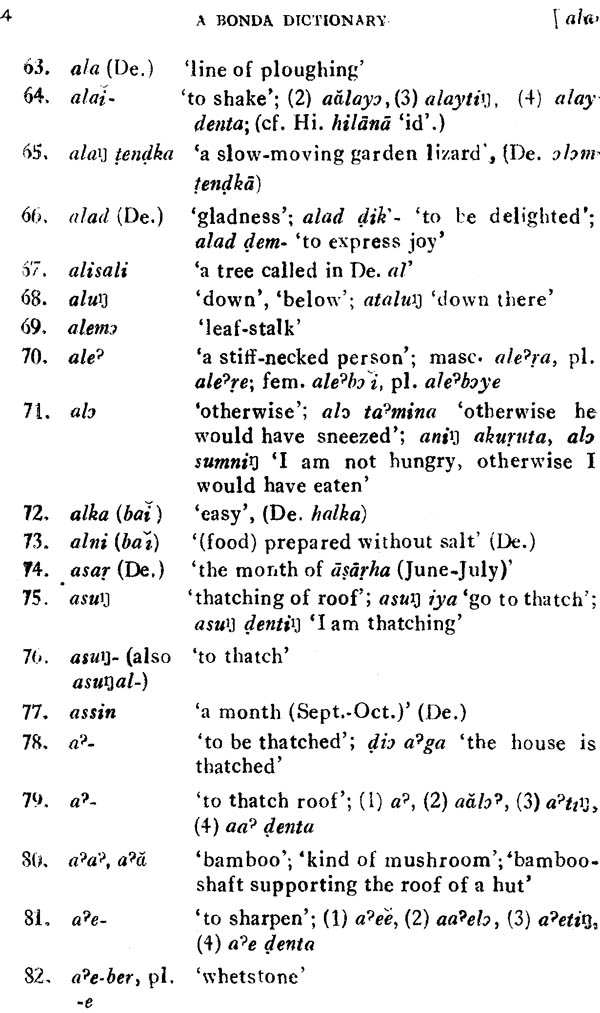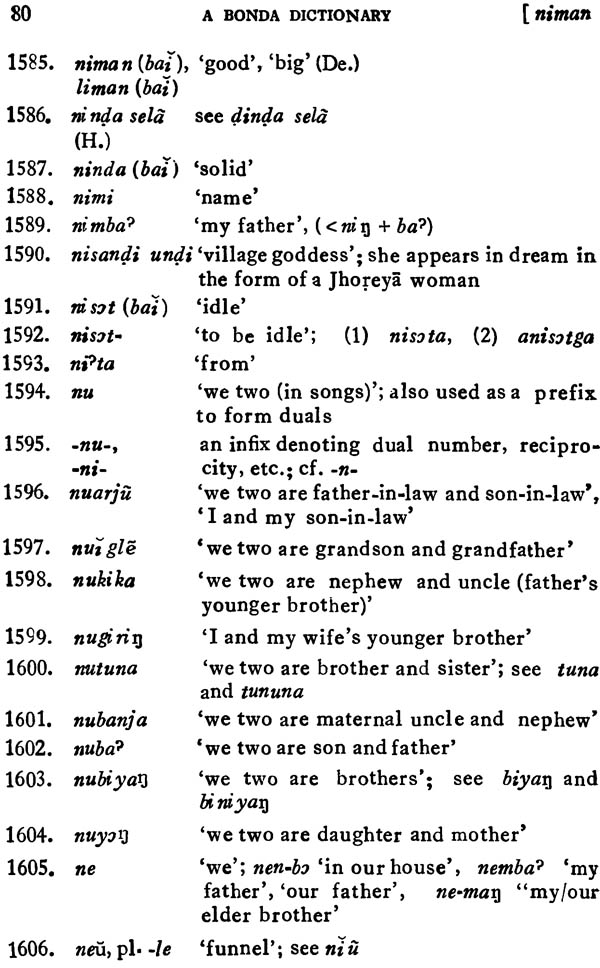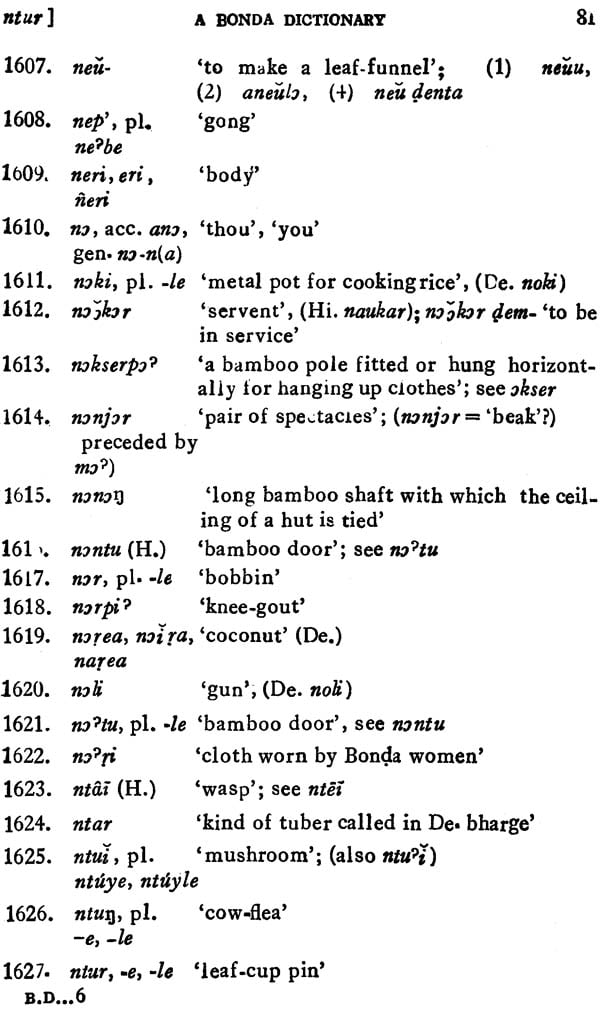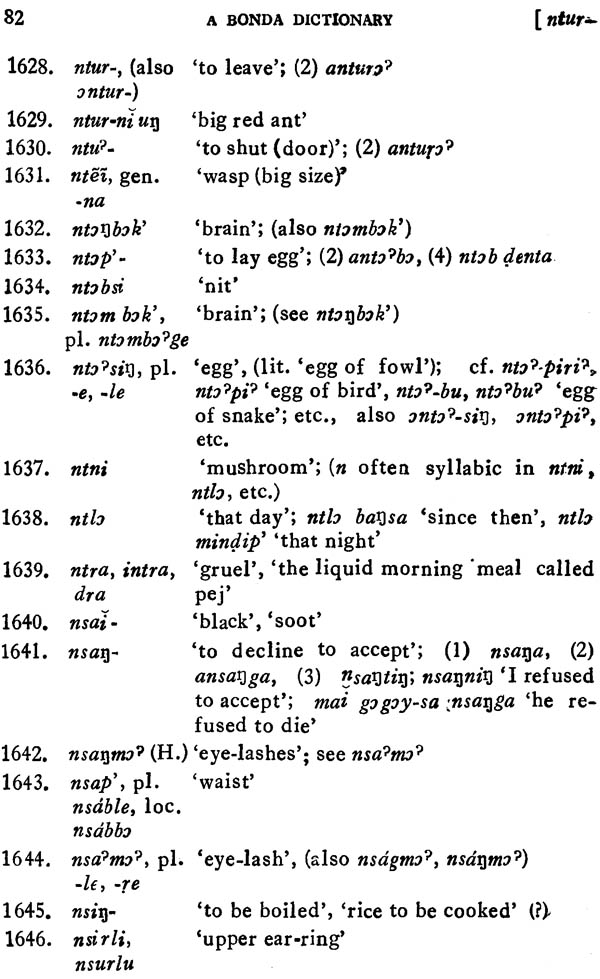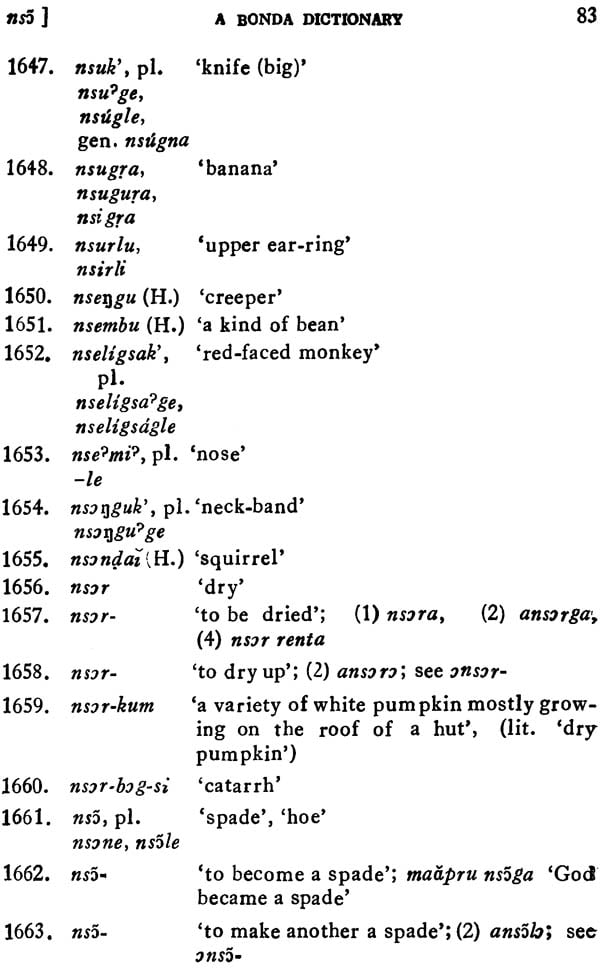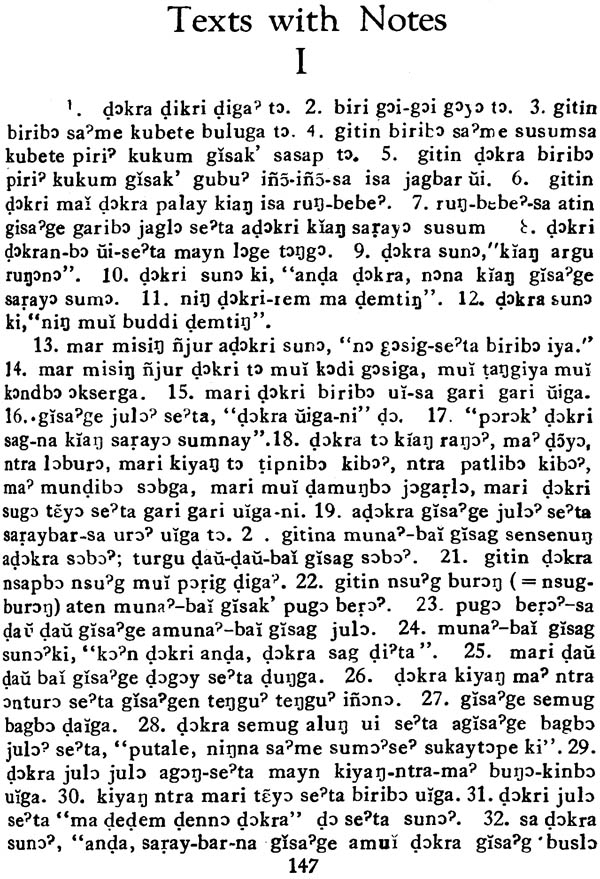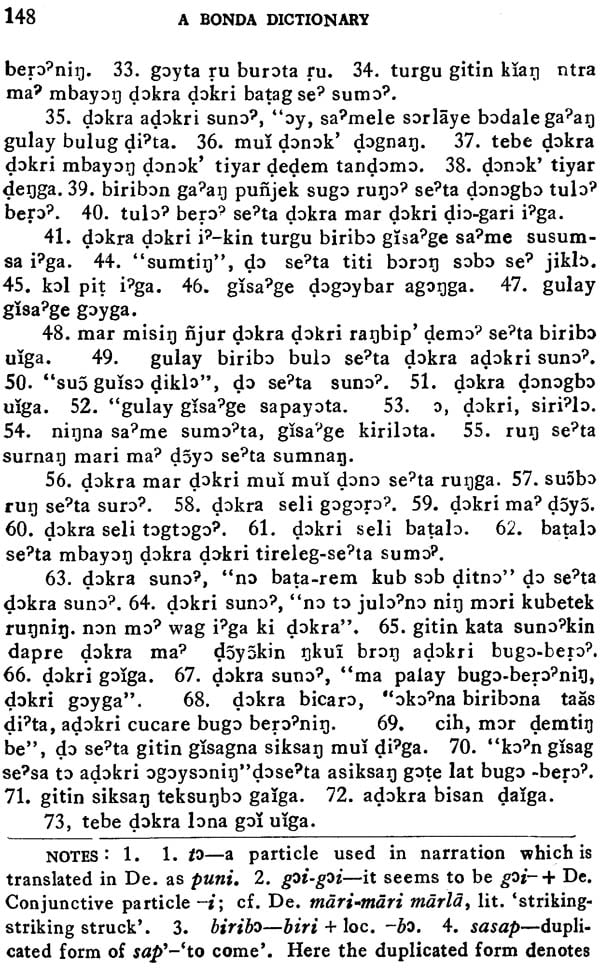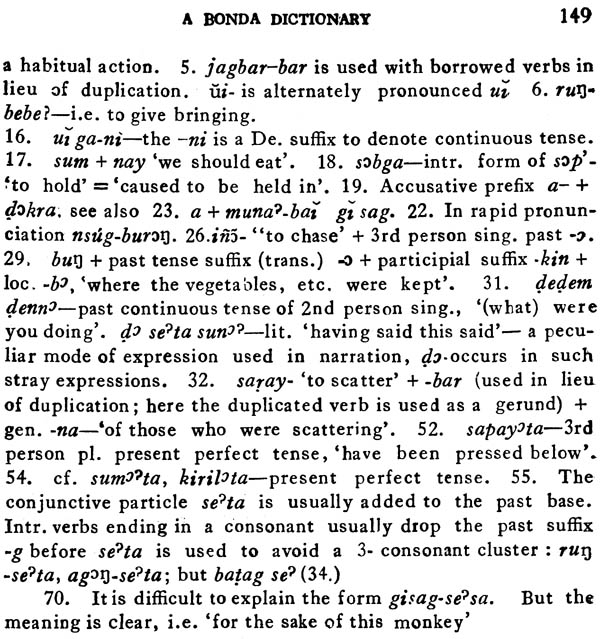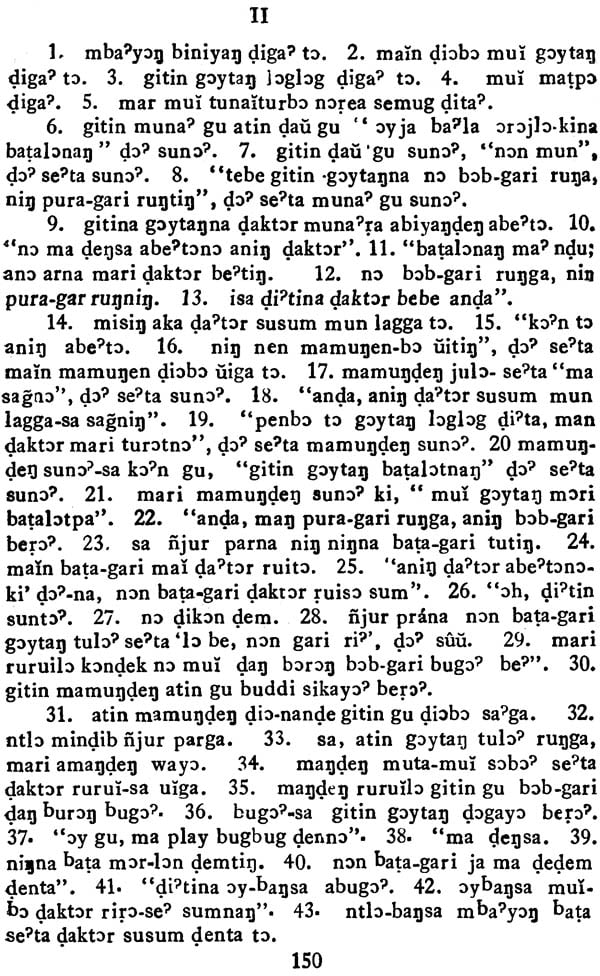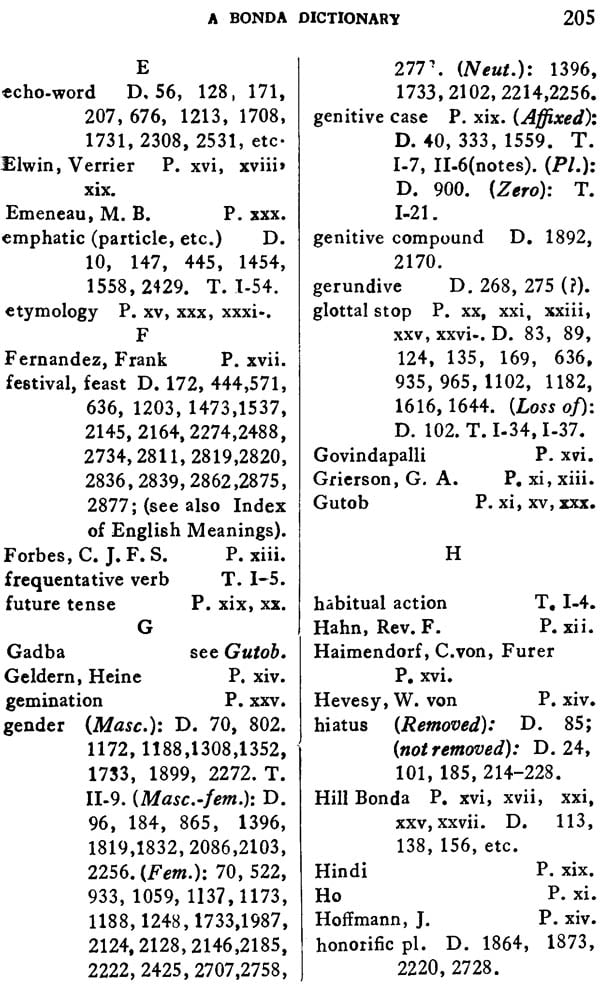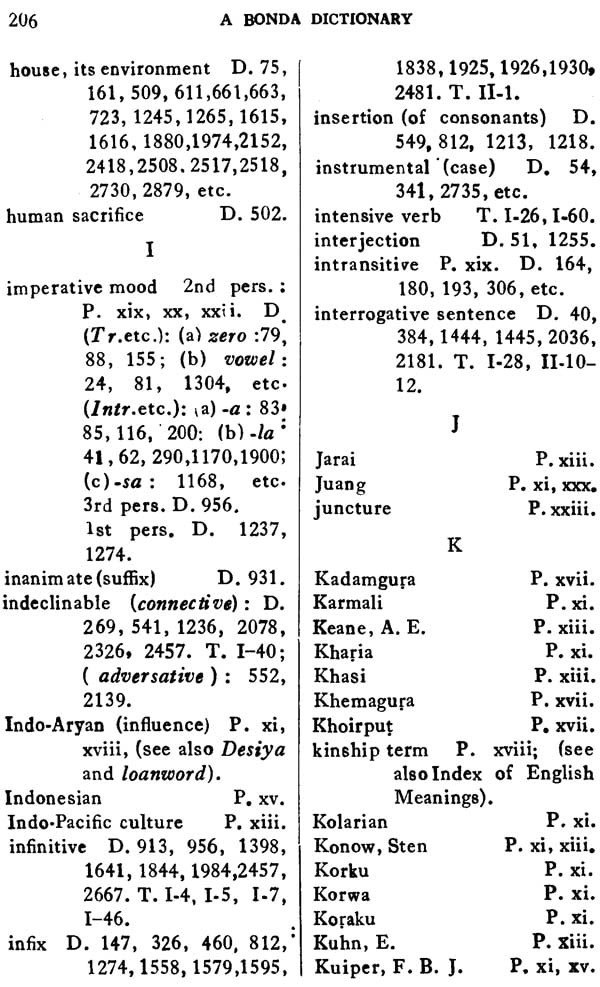
A Bonda Dictionary (An Old and Rare Book)
Book Specification
| Item Code: | NAM056 |
| Author: | Sudhibuhshan Bhattacharya |
| Publisher: | Deccan College Postgraduate and Research Institute |
| Language: | English |
| Edition: | 1968 |
| Pages: | 252 |
| Cover: | Paperback |
| Other Details | 8.5 inch x 5.5 inch |
| Weight | 310 gm |
Book Description
On the 15th of October 1964 the Deccan College celebrated the centenary of its main Building, and curiously enough this period coincided with the Silver Jubliee of the Postgraduate and Research Institute which as successor to the Deccan College, started functioning from 17th August 1939 when members of the teaching faculty reported on duty. When I suggested to members of our faculty the novel idea that the centenary should be celebrated by the publication of a hundred monographs representing the research carried on under the auspices of the Deccan College in its several departments they readily accepted the suggestion. These contributions are from present and past faculty members and research scholars of the Deccan College, giving a cross-section of the manifold research that it has sponsored during the past twentyfive years. From small beginnings in 1939 the Deccan College has now grown into a well developed and developing Research Institute and become a national centre in so far as Linguistics, Archaeology and Ancient India History, and Anthropology and Sociology are concerned. Its international status is attested by the location of the India Institute of German Studies (jointly sponsored by the Deccan College and the Goethe Institute of Munich), the American Institute of Indian Studies and a branch of the Ecole Francaise d’ Extreme-Orient in the campus of the Deccan College. The century of monographs not only symbolises the centenary of the original building and the silver jubilee of the Research Institute, but also the new spirit of critical enquiry and the promise of more to come.
There are some interesting tribes in Central India who speak languages not affiliated to Indo-Aryan or Dravidian’. This third speech-group is known as ‘Munda’ or ‘Kolarian’. Sixteen major speeches of this group have so far been studied by us. They are mostly spoken in Orissa, Bihar, West Bengal and Madhya Pradesh. The Munda speeches arranged geographically from the south are: (1) Didey (145), (2) Bonda or Bondo (Remo) (2568), (3) Gadba (Guto b) (54,454), (4) Parengi (824), (5) Savara (Sora) (2,56,260), (6) Juang (12,559), (7) Ho (5,99,876), (8) Mundari (5,85,297), (9) Kharia (93,417), (10) Santali (29,61,324), (11) Asuri (1,510), (12) Birhor (37), (13) Koraku (?), (14) Korowa (26,477), (15) Mowasi (17,896), and (16) Korku (1,70,571). The numbers shown in the brackets after each speech indicate the number of speakers of that speech according to the Census of India for 1951. The list the Munda speeches given above exclude s some dialects, namely, Karmali, Mahle, Bhumij, Turi, etc. men-lioned in the Linguistic Survey of India, Vol. IV. Nahali has also been omitted for reasons discussed in my article on Nahali. But Didey, Bonda and Koraku (of Surguja) are new items in our list. These tongues were not recorded for the purpose of the Linguistic Survey of India.
The Munda people received little attention from the western scholars in the past. The Missionaries who entered this area from the north, i.e. Bengal, came in contact with the Santals first, and since the Santals resemble the Dravidian-speaking Oraons in some respects, this perhaps gave rise to a notion that the Santals and other people of that speech-group are related to the Dravidian speakers of the south.
In 1854 Max Muller first came out with a definite theory about the Mundas. He assigned to them a separate culture bloc and for the first time used the term ‘Munda’ to denote it. He was future of the opinion that the Mundas are related to the ancient Turanians of the West. According to him the Munda languages were spoken in India ‘before the Tamulian conquest’.
The old idea that the Mundas have special connexions with the Dravidians, however, still persisted, and in 1900 Rev. F. Hahn in his Kurukh Grammar made a serious attempt tor establish that the so called Munda languages are Dravidian in origin. Inadequate knowledge about the Munda languages was primarily responsible for this erroneous out-look.
While the Indologists were thus engaged in finding out different prehistoric culture blocs in India, some of the western scholars who took up the study of the Far East became interested in a South-East Asiatic culture which from ancient time was spread over a vast area including Australia, New Guinea, Indo-China, Malay, other countries of the Far East and India. J. R. Logan in his articles entitled ‘Ethnology of the Indo-Pacific Islands’ (1852-56) discussed the possibilities of an Austro-Asiatic culture prevailing in the countries between Australia and India. After him Forbes, Keane, Kuhn and others pursued the same line of research. But want of reliable and adequate informations on the Munda speaking peoples prevented them from giving a clear verdict on the question whether the Indo-Pacific culture zone touched only the eastern border of India, i.e. the lands of the Khasis and the Nicobarese, or it penetrated deep into the Indian sub-continent.
With the beginning of the present century P.W. Schmidt appeared on the scene with a resolution to clinch the issue. He published a number of articles from 1901 to 1905 discussing the relationship between the Mon-Khmers and the Mundas. By the term “Mon-Khmer” was at that time meant not only the speeches of the Mons and the Khmers, but also many other speech-groups, namely, Nicobarese, Cham, Jarai, Rade, Sedang, Semang, Sakai, and the Khasi. Finally in 1905, he collected all the linguistic and anthropometric data available on the subject, and sought to establish that the proposed connexion between the Mon-Khmers and the Mundas was no longer a hypothesis. He grouped them under Austroasiatic and went further and assigned a bigger area to this South-East Asiatic culture bloc by propounding his ‘Austric’ theory which sought to connect the Austroasiatic language and culture group to another one called Austronesian.
Schmidt’s theory was promptly accepted by Blagden (Pagan Races of the Malay Peninsula, 1906), and Grierson and Sten Konow (Linguistic Survey of India, Vol. IV 1906). It should be mentioned here that at the time Schmidt was working on his thesis, some reliable accounts on the Santals and a meagre knowledge of the Pronominalized Himalayan speeches, and some information on a few other languages of the Munda group, were only available on the subject, and Schmidt had to be content with that much only.
Schmidt’s theory, however, received support from different branches of science. Heine Geldern and Przyluski lent their support to the view from their respective stand-points of Prehistoric Arhcaeology and Ethnology (1929). The idea of the existence of an Indo-Pacific relationship in pre- historic times became further strengthened when the colonial conquests of the Hindus in the Pacific islands in historic times came to light.
Thus everything was turning out to be favourable to Schmidt’s theory till the thirties of the present century, when a Hungarian scholar de Hevesy emphatically stated that the Munda languages of Central India have nothing to do with the Austroasiatic speeches of the East. They are, in his opinion, related to the Ural-Altaic languages of the Eurasiatic countries, which was practically reverting to the same direction pointed out by Max Muller. But the progress in the matter of acquiring fresh material on the Munda speakers was not sufficient even at the time of de Hevesy, the only remarkable addition about that time being Hoff mann’s excellent account of the Mundari people.
In the forties of the present century, two American scholars re-examined Schmidt’s data. Sebeok (1942) examined them from the linguistic point of view and Gordon Bowles (1943) from the anthropometric. Both of them failed to accept Schmidt’s theory on ground of inadequacy of the proofs adduced by him. In 1948 in his article on “Munda and Indonesian” F.B.J. Kuiper gave more proofs in support of Schmidt’s theory, and concluded his article by saying that the ‘Munda languages will prove to be of greater and more vital interest for Indonesian linguistics than they are generally held to be. Some attempts have also been made in the past to connect the Munda languages with Buru-shaski and the Chinese languages.
To sum up, the present writer wishes to make the following suggestions. Firstly, we may now study the Munda problem from three different platforms, namely, linguistic, anthropometric and cultural, and then compare the results. If the results do not agree in all the details we should not be surprised or sorry, for race, language and culture change in their own ways, and in their own rates of speed. Secondly, in our linguistic enquiry we should now put greater stress on the etymological studies. If a complete set of phonetic correspondences could be established amongst the different “Aus-troasiatic” or “Austric” languages, that should conclusively prove a genetic connection between these languages, and their differences in the mode of affixation and other respects will become immaterial. Thirdly, we should exclude the Himalayan languages from the Munda group and include in it the five southern languages, namely, Sora, Parengi, Gutob, Bonda and Didey. We should also split up the Mon-Khmer languages into its different components detailed above for convenience of etymological studies.
We have given above a short survey of a problem in our ethno-history which if pursued properly may one time lead to the establishment of a prehistoric migration of a very ancient group of people over a distant area extending from the northern and eastern parts of Europe to Australia. It is likely that the language of this people is still retained, though in a greatly acculturated form, by their descendants and others who came in contact with them throughout this long passage. The study of the obscure Munda languages of Central India, particularly its southern group about which our knowledge is inadequate, becomes very urgent in view of the problem discussed by us in the foregoing paragraphs.
Bonda is a primitive tribe of Orissa who speak a language of the southern Munda group. We knew little about this language so long. Our object here is to publish a short Dictionary of the Bonda language and some Bonda texts as a measure to remove partially the lacunae existing in the domain of Munda linguistics.
| 1 | Foreword | vii |
| 2 | Abbreviations | ix |
| 3 | Preface | xi |
| The Munda Problem | xi | |
| Source of Our Material | xvi | |
| Sheme of the Present Work | xvii | |
| Orthography and Phonology | xxi | |
| Comparative Munda Studies and Bonda | xxx | |
| 4 | Bonda Dictionary | 1-140 |
| 5 | Appendix | 141-146 |
| 6 | Texts with Notes | 147-157 |
| 7 | English Translation | 158-174 |
| 8 | Index of English Meanings | 175-200 |
| 9 | Index of Latin and Native Terms | 201-202 |
| 10 | General Index | 203-210 |
| Errata | 211-212 |
